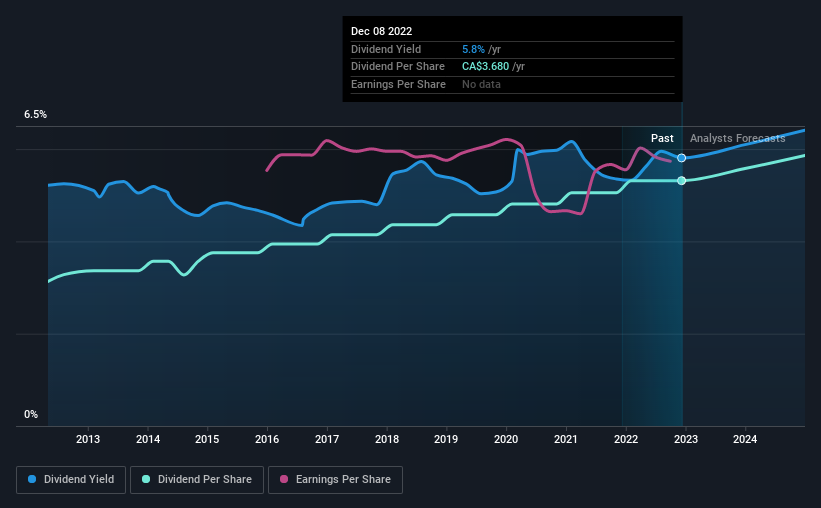Here's Why We're Wary Of Buying BCE's (TSE:BCE) For Its Upcoming Dividend
Regular readers will know that we love our dividends at Simply Wall St, which is why it's exciting to see BCE Inc. (TSE:BCE) is about to trade ex-dividend in the next 4 days. Typically, the ex-dividend date is one business day before the record date which is the date on which a company determines the shareholders eligible to receive a dividend. The ex-dividend date is an important date to be aware of as any purchase of the stock made on or after this date might mean a late settlement that doesn't show on the record date. In other words, investors can purchase BCE's shares before the 14th of December in order to be eligible for the dividend, which will be paid on the 16th of January.
The company's next dividend payment will be CA$0.92 per share. Last year, in total, the company distributed CA$3.68 to shareholders. Last year's total dividend payments show that BCE has a trailing yield of 5.8% on the current share price of CA$63.36. If you buy this business for its dividend, you should have an idea of whether BCE's dividend is reliable and sustainable. That's why we should always check whether the dividend payments appear sustainable, and if the company is growing.
Check out our latest analysis for BCE
If a company pays out more in dividends than it earned, then the dividend might become unsustainable - hardly an ideal situation. BCE paid out 118% of profit in the past year, which we think is typically not sustainable unless there are mitigating characteristics such as unusually strong cash flow or a large cash balance. Yet cash flow is typically more important than profit for assessing dividend sustainability, so we should always check if the company generated enough cash to afford its dividend. Over the last year, it paid out dividends equivalent to 236% of what it generated in free cash flow, a disturbingly high percentage. It's pretty hard to pay out more than you earn, so we wonder how BCE intends to continue funding this dividend, or if it could be forced to cut the payment.
Cash is slightly more important than profit from a dividend perspective, but given BCE's payments were not well covered by either earnings or cash flow, we are concerned about the sustainability of this dividend.
Click here to see the company's payout ratio, plus analyst estimates of its future dividends.
Have Earnings And Dividends Been Growing?
Stocks with flat earnings can still be attractive dividend payers, but it is important to be more conservative with your approach and demand a greater margin for safety when it comes to dividend sustainability. If earnings decline and the company is forced to cut its dividend, investors could watch the value of their investment go up in smoke. That explains why we're not overly excited about BCE's flat earnings over the past five years. Better than seeing them fall off a cliff, for sure, but the best dividend stocks grow their earnings meaningfully over the long run.
Another key way to measure a company's dividend prospects is by measuring its historical rate of dividend growth. In the past 10 years, BCE has increased its dividend at approximately 5.4% a year on average.
To Sum It Up
Is BCE worth buying for its dividend? Not only are earnings per share flat, but BCE is paying out an uncomfortably high percentage of both its earnings and cashflow to shareholders as dividends. It's not the most attractive proposition from a dividend perspective, and we'd probably give this one a miss for now.
So if you're still interested in BCE despite it's poor dividend qualities, you should be well informed on some of the risks facing this stock. For example, BCE has 2 warning signs (and 1 which is potentially serious) we think you should know about.
If you're in the market for strong dividend payers, we recommend checking our selection of top dividend stocks.
Have feedback on this article? Concerned about the content? Get in touch with us directly. Alternatively, email editorial-team (at) simplywallst.com.
This article by Simply Wall St is general in nature. We provide commentary based on historical data and analyst forecasts only using an unbiased methodology and our articles are not intended to be financial advice. It does not constitute a recommendation to buy or sell any stock, and does not take account of your objectives, or your financial situation. We aim to bring you long-term focused analysis driven by fundamental data. Note that our analysis may not factor in the latest price-sensitive company announcements or qualitative material. Simply Wall St has no position in any stocks mentioned.
Join A Paid User Research Session
You’ll receive a US$30 Amazon Gift card for 1 hour of your time while helping us build better investing tools for the individual investors like yourself. Sign up here

 Yahoo Finance
Yahoo Finance 
